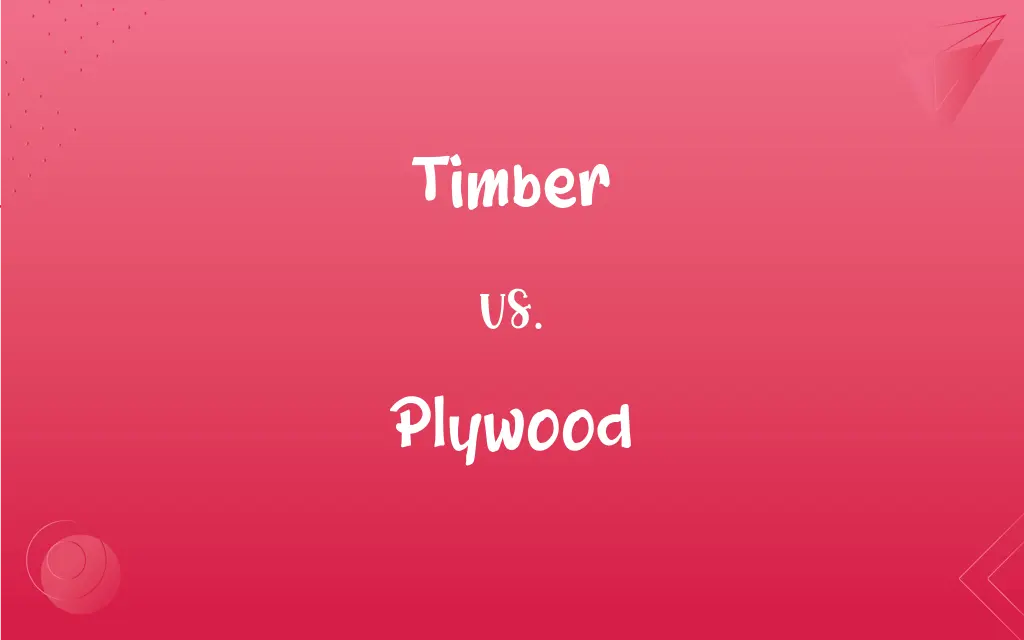Timber vs. Plywood: What's the Difference?
Edited by Janet White || By Harlon Moss || Published on December 9, 2023
Timber refers to wood in its natural, unprocessed form or as a material for construction, whereas plywood is a manufactured wood product made from thin layers of wood veneer.

Key Differences
Timber is wood that has been cut from trees and is used either in its rough form or as processed lumber for construction and furniture. Plywood, on the other hand, is an engineered wood product made by gluing together thin layers of wood veneer.
The strength of timber depends on the type of tree and how it's cut, offering natural beauty and variability. Plywood, being a composite material, has uniform strength and appearance due to its layered construction.
Timber can be affected by environmental factors like moisture and pests, requiring treatment for durability. Plywood is more resistant to warping and cracking, as the cross-graining provides dimensional stability and resistance to environmental changes.
In construction, timber is valued for its aesthetic appeal and traditional use in framing and structural elements. Plywood is favored for its versatility and is often used for flooring, roofing, and furniture due to its uniformity and strength.
Timber offers the authenticity and unique character of natural wood, it can be more expensive and less environmentally sustainable if not sourced responsibly. While, plywood provides a cost-effective and often more sustainable alternative, with the added benefit of being available in large, consistent sheets.
ADVERTISEMENT
Comparison Chart
Material Type
Natural wood
Engineered wood product
Strength & Appearance
Variable, natural
Uniform, layered
Environmental Resistance
Susceptible to moisture and pests
Resistant to warping and cracking
Usage
Construction, furniture
Flooring, roofing, furniture
Sustainability
Depends on sourcing
Often more sustainable
ADVERTISEMENT
Timber and Plywood Definitions
Timber
Natural Wood.
The cabin was built with pine timber.
Plywood
Engineered Wood.
Plywood is a versatile building material.
Timber
Construction Material.
Timber beams support the house.
Plywood
Manufactured Panel.
Plywood panels were used for the flooring.
Timber
Lumber.
They purchased timber for the new deck.
Plywood
Layered Wood Product.
The shelves were made from plywood.
Timber
Wooden Framework.
The old barn's timber frame stood strong.
Plywood
Cross-Grained Sheets.
The plywood's cross-graining adds strength.
Timber
Raw Wood.
Timber logs were stacked for milling.
Plywood
Composite Wood Material.
Plywood is used for affordable furniture.
Timber
Trees or wooded land considered as a source of wood.
Plywood
A structural material made of layers of wood glued together, usually with the grains of adjoining layers at right angles to each other.
Timber
Wood used as a building material; lumber.
Plywood
(uncountable) Construction material supplied in sheets, and made of three or more layers of wood veneer glued together, laid up with alternating layers having their grain perpendicular to each other.
After the hurricane there was a severe regional shortage of plywood, especially exterior plywood.
Plywood
(countable) A specific grade or type of this construction material.
We stock exterior plywoods, interior plywoods, and furniture plywoods.
Plywood
(transitive) To fit or block up with plywood.
Plywood
A laminate made of thin layers of wood
FAQs
What is timber?
Timber refers to wood that has been processed into beams and planks, a stage in the process of wood production.
Can timber be recycled?
Yes, timber can be recycled and repurposed for various uses.
What are common uses of timber?
Timber is used in construction, furniture making, and as a raw material for paper and pulp production.
Is timber the same as lumber?
In American English, timber often refers to unprocessed wood. In British English, it's synonymous with lumber, meaning processed wood.
What is plywood?
Plywood is a type of engineered wood made by gluing together thin layers or plies of wood veneer.
How long does timber last?
Its lifespan varies depending on the type and treatment but can last decades if properly maintained.
How is timber classified?
It's classified based on tree species (hardwood or softwood) and quality.
Is timber environmentally friendly?
It can be, especially when sourced from sustainable forests.
How is plywood made?
It's made by gluing and pressing layers of wood veneer together under high heat and pressure.
Can plywood be waterproof?
Yes, certain types of plywood are treated to be water-resistant.
Can plywood be painted or stained?
Yes, it can be both painted and stained for aesthetic purposes.
Can timber be used outdoors?
Yes, especially if treated for weather resistance.
What is timber seasoning?
Seasoning is the process of drying timber to reduce its moisture content.
Is plywood strong?
Yes, its cross-grained structure gives it strength and stability.
What are the uses of plywood?
Plywood is used in construction, furniture making, and cabinetry.
Is plywood suitable for outdoor use?
Exterior-grade plywood, designed for outdoor use, is suitable for exterior applications.
Does timber require maintenance?
Yes, regular maintenance like sealing or painting helps prolong its life.
Is plywood eco-friendly?
It can be, particularly when made from sustainably harvested wood.
What is marine plywood?
Marine plywood is specially designed to resist water and humidity, used primarily in boat construction.
What are the different grades of plywood?
Plywood is graded based on the quality of the veneers and the presence of defects.
About Author
Written by
Harlon MossHarlon is a seasoned quality moderator and accomplished content writer for Difference Wiki. An alumnus of the prestigious University of California, he earned his degree in Computer Science. Leveraging his academic background, Harlon brings a meticulous and informed perspective to his work, ensuring content accuracy and excellence.
Edited by
Janet WhiteJanet White has been an esteemed writer and blogger for Difference Wiki. Holding a Master's degree in Science and Medical Journalism from the prestigious Boston University, she has consistently demonstrated her expertise and passion for her field. When she's not immersed in her work, Janet relishes her time exercising, delving into a good book, and cherishing moments with friends and family.







































































